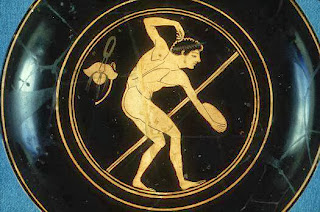One myth says that the guardians of the infant god Zeus held the first footrace, or that Zeus himself started the Games to celebrate his victory over his father Cronus for control of the world. Another tradition states that after the Greek hero Pelops won a chariot race against King Oenomaus to marry Oenomaus's daughter Hippodamia, he established the Games.

Boxing: Ancient boxing had fewer rules than the modern sport. Boxers fought without rounds until one man was knocked out, or admitted he had been beaten. Unlike the modern sport, there was no rule against hitting an opponent when he was down.
There were no weight classes within the mens' and boys' divisions; opponents for a match were chosen randomly. Instead of gloves, ancient boxers wrapped leather thongs (himantes) around their hands and wrists which left their fingers free.
Chariot Racing: There were both 2-horse chariot and 4-horse chariot races, with separate races for chariots drawn by foals. Another race was between carts drawn by a team of 2 mules. The course was 12 laps around the stadium track (9 miles).

Riding: The course was 6 laps around the track (4.5 miles), and there were separate races for full-grown horses and foals. Jockeys rode without stirrups.
Only wealthy people could afford to pay for the training, equipment, and feed of both the driver (or jockey) and the horses. As a result, the owner received the olive wreath of victory instead of the driver or jockey.
 Pankration: This event was a grueling combination of boxing and wrestling. Punches were allowed, although the fighters did not wrap their hands with the boxing himantes. Rules outlawed only biting and gouging an opponent's eyes, nose, or mouth with fingernails. Attacks such as kicking an opponent in the belly, which are against the rules in modern sports, were perfectly legal.
Pankration: This event was a grueling combination of boxing and wrestling. Punches were allowed, although the fighters did not wrap their hands with the boxing himantes. Rules outlawed only biting and gouging an opponent's eyes, nose, or mouth with fingernails. Attacks such as kicking an opponent in the belly, which are against the rules in modern sports, were perfectly legal.Jump: Athletes used lead or stone jump weights (halteres) shaped like telephone receivers to increase the length of their jump. The halteres were held in front of the athlete during his ascent, and forcibly thrust behind his back and dropped during his descent to help propel his body further.
Running: There were 4 types of races at Olympia. The stadion was the oldest event of the Games. Runners sprinted for 1stade (192 m.), or the length of the stadium. The other races were a 2-stade race (384 m.), and a long-distance run which ranged from 7 to 24 stades (1,344 m. to 4,608 m.). And if these races weren't enough, the Greeks had one particularly grueling event which we lack. There was also a 2 to 4-stade (384 m. to 768 m.) race by athletes in armor. This race was especially useful in building the speed and stamina that Greek men needed during their military service.
Wrestling: Like the modern sport, an athlete needed to throw his opponent on the ground, landing on a hip, shoulder, or back for a fair fall. 3 throws were necessary to win a match. Biting was not allowed, and genital holds were also illegal. Attacks such as breaking your opponent's fingers were permitted.
Student's will write a 4-6 sentence paragraph describing about on of the sports that were played during the Ancient Olympics.





